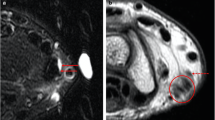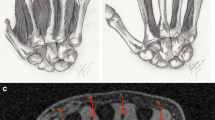Abstract
Objective
To present the MRI imaging findings of extensor tenosynovitis at the distal intersection or crossover between the second (extensor carpi radialis longus (ECRL) and brevis (ECRB)) and third (extensor pollicis longus (EPL)) extensor compartment tendons, and the anatomical details that may play a role in the pathogenesis of this condition.
Design and patients
The imaging studies and clinical records of five patients (three females and two males, with ages ranging between 22 and 78 years; mean age, 49 years) presenting with pain on the dorsal and radial aspect of the wrist were reviewed by two musculoskeletal radiologists in consensus. Three cases were identified serendipitously during routine clinical reading sessions; a follow-up computerized database search for additional cases reported in the prior two years yielded two additional cases. The overall number of cases screened was 1,031. The diagnosis of tendinopathy affecting the second and third compartment extensor tendons was made on the basis of MRI findings and clinical follow-up, or synovectomy.
Results
All patients showed signs of tenosynovitis: in four patients both the tendons of the second and third extensor compartments were affected; the fifth patient showed signs of tenosynovitis of the EPL tendon, and tendinosis of the extensor carpi radialis tendons. Three patients showed tenosynovitis proximal and distal to the point of intersection; and in two of them, a discrete point of constriction was appreciated at the crossover site in relation to the extensor retinaculum. Two patients showed tenosynovitis limited to the segment distal to the point of decussation. Tendinosis tended to follow the presence of tenosynovitis. In one of the patients, subtendinous reactive marrow edema in Lister’s tubercle was noted.
Conclusion
Distal intersection tenosynovitis may be related to the biomechanical pulley effect exerted by Lister’s tubercle on the EPL tendon as it leaves the third compartment and crosses over the extensor carpi radialis tendons, as well as the constraining effect of the extensor retinaculum. These anatomical features determine the presence of characteristic MR imaging findings.




Similar content being viewed by others
References
Clavero JA, Golano P, Farinas O, Alomar X, Monill JM, Esplugas M. Extensor mechanism of the fingers: MR imaging-anatomic correlation. Radiographics 2003;23(3):593–611.
Bonatz E, Kramer TD, Masear VR. Rupture of the extensor pollicis longus tendon. Am J Orthop 1996;25(2):118–22.
De Lima JE, Kim HJ, Albertotti F, Resnick D. Intersection syndrome: MR imaging with anatomic comparison of the distal forearm. Skeletal Radiol 2004;33(11):627–31.
Grundberg AB, Reagan DS. Pathologic anatomy of the forearm: intersection syndrome. J Hand Surg [Am] 1985;10(2):299–302.
Idler RS, Strickland JW, Creighton JJ Jr. Intersection syndrome. Indiana Med 1990;83(9):658–9.
Helal B, Chen SC, Iwegbu G. Rupture of the extensor pollicis longus tendon in undisplaced Colles’ type of fracture. Hand 1982;14(2):41–7.
Engkvist O, Lundborg G. Rupture of the extensor pollicis longus tendon after fracture of the lower end of the radius. A clinical and microangiopathic study. Hand 1979;11(1):76–86.
Hirasawa Y, Katsumi Y, Akiyoshi T, Tamay K, Tokioka T. Clinical and micoangiopathic studies on rupture of the EPL tendon after distal radius fractures. J Hand Surg 1990;15B(1):51–7.
Lloyd TW, Tyler MP, Roberts AH. Spontaneous rupture of extensor pollicis longus tendon in a kick boxer. Br J Sports Med 1998;32(2):178–9.
Fujita N, Doita M, Yoshikawa M, Fujioka H, Sha N, Yoshiya S. Spontaneous rupture of the extensor pollicis longus tendon in a professional skier. Knee Surg Sports Traumatol Arthrosc 2005;13(6):489–91.
Morrison WB, Carrino JA, Schweitzer ME, Sanders TG, Raiken DP, Johnson CE. Subtendinous bone marrow edema patterns on MR images of the ankle. Association with symptoms and tendinopathy. AJR 2001;176:1149–54.
Author information
Authors and Affiliations
Corresponding author
Rights and permissions
About this article
Cite this article
Parellada, A.J., Gopez, A.G., Morrison, W.B. et al. Distal intersection tenosynovitis of the wrist: a lesser-known extensor tendinopathy with characteristic MR imaging features. Skeletal Radiol 36, 203–208 (2007). https://doi.org/10.1007/s00256-006-0238-6
Received:
Revised:
Accepted:
Published:
Issue Date:
DOI: https://doi.org/10.1007/s00256-006-0238-6




